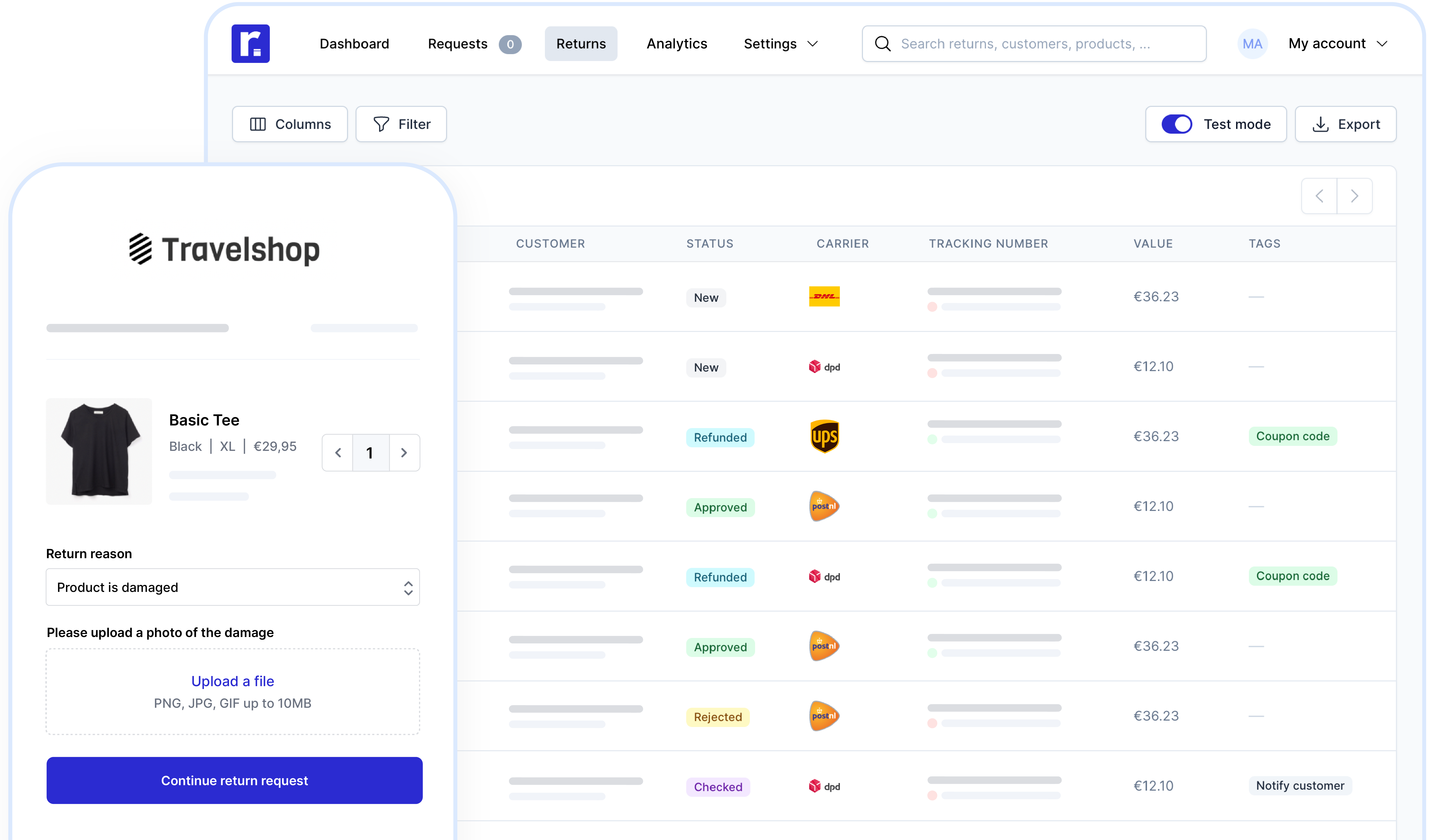
Author
Maxine Alders
Date
24 April 2024
Category
Informative
What's a return policy?
The right of withdrawal gives consumers in the EU the right to return products they have purchased without giving a reason. Part of the right of withdrawal is a statutory 14-day cooling-off period, during which consumers are entitled to a full refund of the purchase price, including shipping costs. A merchant's return policy includes all conditions related to compliance with the right of withdrawal.
In this article you will read why a good return policy is particularly important for merchants and how best to implement it.
Why do you need a good return policy?
Initially, the right of withdrawal was introduced to protect consumers. In distance selling, there is no personal interaction between buyer and seller, which means the goods can only be inspected after delivery. The right of withdrawal creates a sense of security and trust among consumers because it gives them the assurance that they can return the product upon receipt if they are found to be unsatisfied.
With a solid return policy and clear return conditions, you can confirm and validate your brand image. Clear information about the return process on your website is important to gain the trust of potential customers. A customer-friendly returns process also contributes to customer loyalty. If the return or exchange of a purchase is handled in no time, the person is more likely to order from you again in the future. Therefore, the right of withdrawal is not only a necessary evil; it is also part of your business strategy and can increase your distinctiveness.
The importance of a return policy.
We've already established that a clear return policy helps gain your customers' trust. However, it can also help speed up consumers' purchasing decisions. Research has shown that 67% of all consumers check the return policy before making a purchase. If the information about your return policy is hard to find or unclear, or even completely missing, you will lose potential conversions.
A good return policy with clear return conditions is therefore an essential part of your value proposition - and can contribute significantly to increasing your conversion rate. All information about return options and the legal return period should be easy to find on your website. Let your customers know how much time they have to return purchased products and who exactly bears the return costs in which cases.

Important components of a return policy.
An effective return policy considers several aspects. First, it should include the return period, i.e., how long after receipt customers can return their products. Another important issue is the return cost: who pays for the return? Free returns can be an attractive USP (unique selling point) for your store, but you are not legally obligated to cover them.
In addition, you would do well to define return conditions for different product categories, for example for perishable goods or hygiene products. Moreover, it is important to specify the different return methods in your return policy. Can products be returned in a physical store or does everything go through return shipping? Finally, you should let customers know through your return policy when they can expect a refund of the purchase price and what alternatives, if any, you offer (think coupon codes, for example).
Let's take a closer look below at what should be included in your return policy.
1. Return time: how long does the customer have to return something?
The return period - how long after receipt customers can return their products - is probably the most important part of the return policy. The legal return period is set at EU level and is 14 days. In most cases, this gives the customer enough time to decide whether or not to keep the goods. Nevertheless, you may want to consider extending this period. A longer return period can not only be an additional unique selling point for your online store, but, according to research, often leads to fewer returns. Why this is the case is unknown, despite several theories. Perhaps the urgency to return the product disappears into the background when the return period is longer and then people forget to actually return the product. The so-called possession effect, also known as the endowment effect, may also play a role. The longer the goods are in the customer's possession, the more value he or she will attach to them.
However, the return period should not be too long, because then you run the risk of receiving old products that you can no longer resell. A return period of one year, like at IKEA, is therefore not recommended. A return period of 30 to 90 days is ideal. This allows you to enjoy all the benefits of an extended return period, but still get the goods back within a reasonable period of time.
2. Return costs - what are the costs for returning products?
When products are returned, there are, of course, shipping costs involved. As an merchant, you are not obliged to pay these, even though it may make sense in certain cases - for example, in the case of damaged products or to increase your competitiveness in general. However, return costs are a major expense for man merchants. Read our blog “Paid or free returns?” to find out how to cleverly offer both paid and free returns in your returns process.
Tip: Returnless lets you deploy return rules to determine in which cases the customer must bear the return cost and when you offer a free return.
Return costs also come from personnel costs, and the time that it takes to process your returns. The return is first received in your warehouse, then registered in the system, then stored and processed in the warehouse, and finally, of course, the refund must be authorized and paid out so that the customer receives a refund.
Tip: With a digitized and fully automated returns process where your customers can register their returns online, you can significantly reduce these costs. After all, this saves you a lot of manual work - and the associated personnel costs.
3. What should the customer do?
Of course, as a merchant, you are not the only one with obligations when it comes to returns. For example, the customer is obliged to return the products in good condition in the original, undamaged packaging. Therefore, you would do well to also set out the rules and regulations for the various product categories in your returns policy.
Unless otherwise stated, goods must be returned in their original packaging, intact, unused and including any accessories. Some products are also excluded from exchange or return, such as cosmetics (perfume, for example) or perishable products. The customer is obliged to accept this right.
The goods must also be returned in accordance with the seller's instructions. This includes carefully filling out the return form so that the return is processed correctly and, if necessary, paying the shipping costs.
4. Return options
What shipping options and carriers do you offer for returns? Your return policy should state the channels through which your customers can return their products.
Do you also have physical stores? Then consider offering in-store returns as an option. Keep in mind that this involves a number of logistical issues; for example, you need to be able to evaluate on-site if you can immediately put the goods back on sale, you need to have refund methods ready, and you need to have a proper system for processing returns.
There are also several options for postal returns. For example, you can offer different shipping companies so that your customers always have a shipping point near them. There are also transport companies that will pick up return packages directly from you or make it possible to send returns via a QR code (and thus without having to print anything). These are further unique selling points that increase the quality of the customer experience - being able to return products easily is a big plus for (potential) customers.
5. When can customers expect their money back?
Finally, you should let customers know through your return policy when they can expect their money back. As a rule, the customer receives the refund a few business days after you receive the return. Refunds are a tricky subject and they often raise questions, for example, when refunds take a little longer due to holidays or busy work hours. Make sure these deadlines are clearly highlighted in your return policy.
Tip: By keeping customers informed through notifications or, even better, through a returns portal where they can check the status of their returns at any time, you can minimize the number of questions. Customers are thus automatically notified as soon as the return is received, authorized and when the refund is initiated.
As an alternative to a cash refund, you can also offer a coupon code. With this method, the customer receives a coupon code with store credit that he or she can redeem directly at your online store. For you as a merchant, this method offers the advantage of maintaining revenue and increases the chance that the customer will buy from you again.
Tip: When a customer wants to exchange, offer a store credit instead of a refund. This retains your revenue and increases the chance that the customer will buy a replacement product from you.
Tips for a good return policy
Return policies are often neglected by merchants. But, just like an optimal shopping experience, a smooth return process can persuade your customers to choose to buy at your store. The clearer your return policy, the better. A transparent returns process can also contribute to your branding, for example, if your focus is on sustainability or providing excellent customer service.
Here are some tips for elements you will encounter in a good returns policy.
Tip 1: Warranty
Consider including your warranty terms in your return policy. Under EU law, consumers are entitled to a statutory warranty of at least two years, which protects them in case of defects or deviations from the advertised characteristics of the goods. As a merchant, you are obliged to take back the goods within this legal warranty period if defects are found, if the products do not match the product description, or if the products have features or designs that differ from the description. In addition, customers can return a product if it is found to be unsuitable for its intended purpose or does not have the quality and/or performance that is normal for this type of product. Even if the product is damaged because you provided inadequate installation instructions, you are liable for the damage under the warranty terms.
Tip 2: Possibility of exchange
What exchange options do you offer? Can customers exchange products in-store or is exchange only possible by returning a product and then reordering? With Returnless, you can offer store credit via a coupon code and, if necessary, offer incentives to make this option more attractive to customers.
If exchanges can only be made via return shipping, it's helpful to include options for this directly in your return terms and conditions as well. Especially if you offer multiple carriers and shipping methods. A smooth exchange process also gives the customer experience another significant boost.
Tip 3: Great service
Is excellent customer service part of your brand identity? Your return policy is the perfect place to reaffirm this. How much trouble do customers have to go through to return a product? The more obstacles you can remove and the more transparent the handling of a return is, the easier returning will be for your customers and the more likely they are to order from you again in the future. So make sure you clearly state all rights and obligations regarding returns and arrange a clear contact form or detailed FAQ database where your customers can go with questions.
Tip 4: Be flexible
Be flexible with your return options, for example by offering different carriers and/or return options. Nowadays, many customers expect flexibility when returning products and don't want to spend too much time and effort on it. So being able to offer different options is a big plus.
Tip 5: Value your loyal customers
Do you have a loyalty program where members get free returns, for example? Do you offer free shipping for orders over a certain amount? These are all unique selling points that you should definitely include in your return policy, as they can persuade customers to make a purchase. Be clear on how you reward loyal customers and chances are you will turn one-time shoppers into regular customers.
Tip 6: Attention to sustainability
Is sustainability an integral part of your brand identity? There are several ways to offer a sustainable returns process. For example, by encouraging exchanges instead of returns or by emphasizing eco-friendly(er) shipping methods - such as using paperless return methods instead of printed return labels or organizing shipments in a more efficient way.
Tip 7: Be socially engaged
Not only is sustainability a great USP these days, but social engagement is also becoming increasingly important. According to the Edelman Trust Barometer 2020, more than half of all consumers consider social involvement in their purchasing decisions. How do you handle returned products? Do they go back on sale or do you donate them to charity? Show your social commitment in your return policy by being transparent about exactly what happens to products that are returned.
Tip 8: Make sure your return policy is easy to find
It should be clear by now that a good returns policy can make a crucial contribution to increasing the number of conversions for your store. Therefore, make sure your customers can easily find all the information about your return policy. As a rule, this page is linked in the footer. Also, invest in a good FAQ section where you anticipate any questions your customers may have.
How Returnless can help you with your return policy.
Returnless' returns platform allows you to automate your entire returns process - from returns request to returns analysis. The digital return form allows your customers to register their returns themselves. Returnless also offers the largest selection of carriers and shipping methods in the EU, which can be easily added to your returns process. With Returnless, when customers want to exchange products, you can offer a coupon code with shopping credit instead of a refund, so the revenue generated stays in your business. This way you ensure a solid and transparent return policy and a smooth return process for you and your customers.

Contact Returnless for a demo
Have we piqued your interest? And do you want to digitize your return policy and discover all the benefits of Returnless' digital return process? Create a free trial account, schedule a free product demo with one of our experts or find out how Returnless works here.
start nu gratis.
Neem een kijkje en test alle features gratis uit! Of plan een demo met een van onze collega's als je liever eerst meer informatie wilt.

